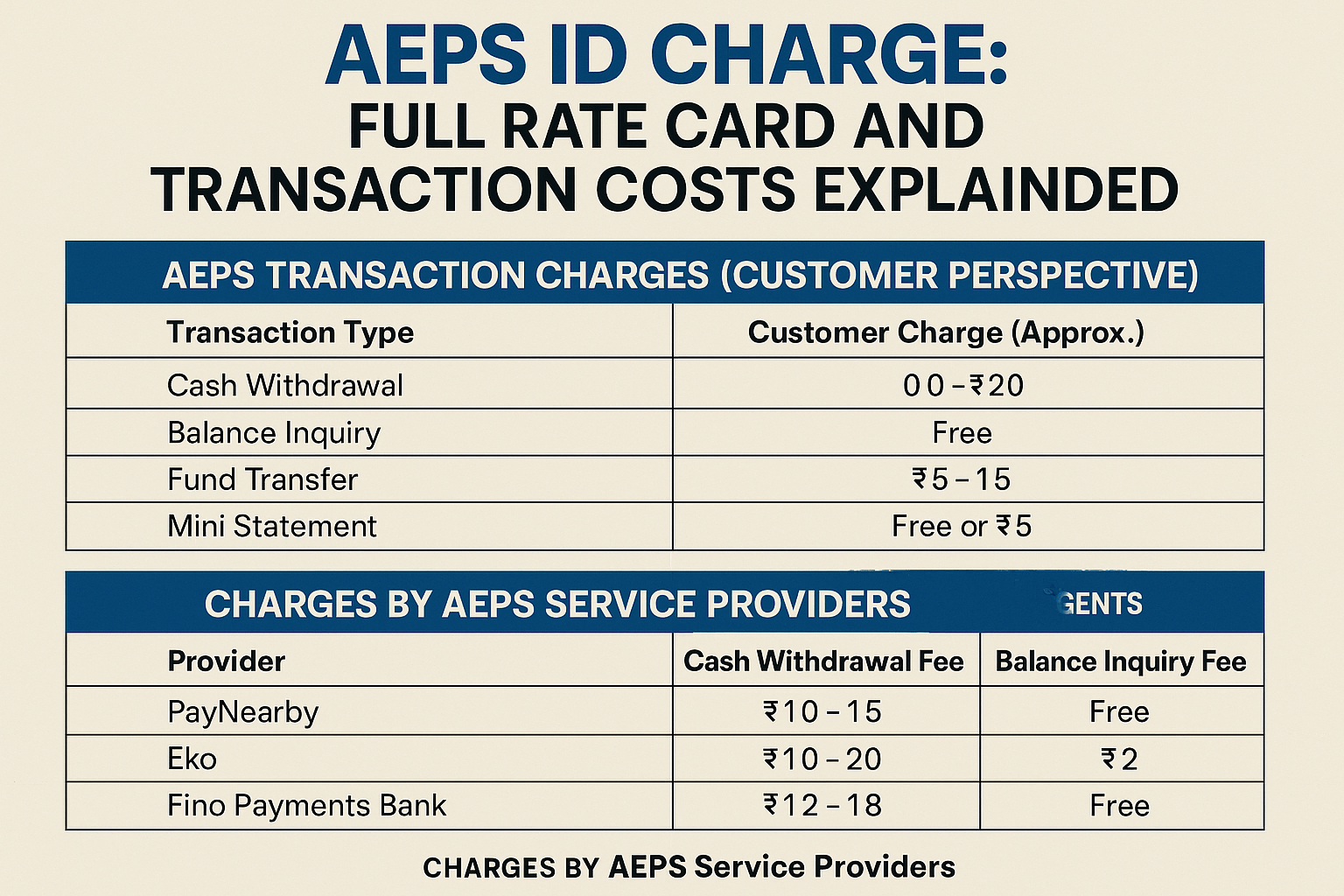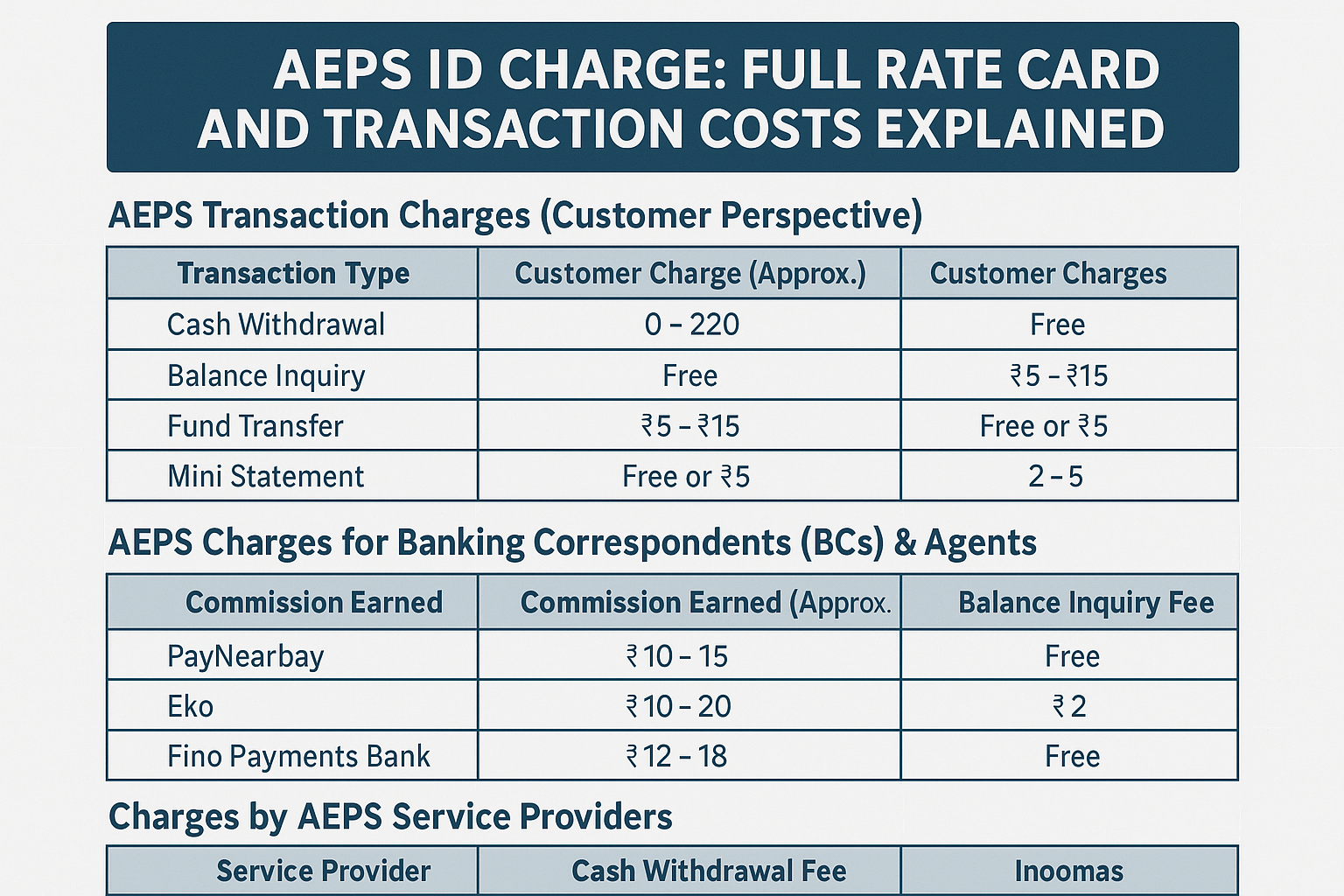If you’ve ever used Aadhaar Enabled Payment System (AEPS) services, you might wonder: How much is the charge for AEPS ID transactions? Whether you’re a customer, a business owner, or a banking agent, understanding the AEPS charges is crucial to managing costs and optimizing transactions.
In this detailed guide, we’ll break down the AEPS ID charge, explore the full rate card, compare different banks and service providers, and answer common questions about fees.
What is AEPS?
AEPS (Aadhaar Enabled Payment System) is a bank-led digital payment model that allows transactions using Aadhaar authentication. It enables:
-
Cash withdrawals
-
Balance inquiries
-
Fund transfers
-
Mini statements
Since AEPS eliminates the need for cards or mobile apps, it’s widely used in rural areas and by banking correspondents (BCs).

How Much is the Charge for AEPS ID?
The AEPS ID charge varies depending on the transaction type and the bank/service provider. Here’s a breakdown of the typical costs:
1. AEPS Transaction Charges (Customer Perspective)
Most banks do not charge customers directly for AEPS transactions. However, some may apply minimal fees:
| Transaction Type | Customer Charge (Approx.) |
|---|---|
| Cash Withdrawal | ₹0 – ₹20 |
| Balance Inquiry | Free |
| Fund Transfer | ₹5 – ₹15 |
| Mini Statement | Free or ₹5 |
Note: Some banks may impose charges if transactions exceed a monthly limit.
2. AEPS Charges for Banking Correspondents (BCs) & Agents
Agents and BCs earn a small commission per transaction. The charges are usually reimbursed by banks or NPCI (National Payments Corporation of India):
| Transaction Type | Commission Earned (Approx.) |
|---|---|
| Cash Withdrawal | ₹5 – ₹15 |
| Balance Inquiry | ₹2 – ₹5 |
| Fund Transfer | ₹5 – ₹10 |
| Mini Statement | ₹2 – ₹5 |
Example: If an agent processes 100 withdrawals in a month at ₹10 per transaction, they earn ₹1,000 as commission.
3. Charges by AEPS Service Providers
Third-party AEPS service providers (like PayNearby, Eko, and Fino Payments Bank) may have different pricing models:
| Provider | Cash Withdrawal Fee | Balance Inquiry Fee |
|---|---|---|
| PayNearby | ₹10 – ₹15 | Free |
| Eko | ₹10 – ₹20 | ₹2 |
| Fino Payments Bank | ₹12 – ₹18 | Free |
Note: These fees may vary based on location and agent agreements.
Factors Affecting AEPS ID Charges
-
Bank Policies – Public sector banks often have lower fees than private banks.
-
Transaction Volume – High-volume agents may get better commissions.
-
Service Provider Markup – Some providers add extra convenience fees.
-
Government Subsidies – DBT (Direct Benefit Transfer) transactions may have waived fees.
How to Reduce AEPS Transaction Costs?
-
Compare service providers before choosing an AEPS partner.
-
Use banks with zero customer charges (e.g., SBI, Bank of Baroda).
-
Negotiate commissions if you’re a high-volume agent.

Frequently Asked Questions (FAQs)
1. Is AEPS free for customers?
Most balance inquiries and some withdrawals are free, but fund transfers may have a small fee.
2. Do agents pay for AEPS transactions?
No, agents earn a commission per transaction instead of paying fees.
3. Which bank has the lowest AEPS charges?
Public sector banks like SBI and PNB usually have minimal or no charges.
4. Can AEPS transactions be done without Aadhaar?
No, AEPS requires Aadhaar-linked bank accounts for authentication.
5. Are there limits on AEPS transactions?
Yes, most banks allow up to ₹10,000 per transaction and ₹50,000 per day.
Conclusion
The AEPS ID charge depends on the bank, transaction type, and service provider. While customers often enjoy free or low-cost transactions, agents earn commissions per transaction. By comparing different providers and understanding the fee structure, you can optimize costs and maximize benefits.
Disclaimer
This post is for educational purposes only. Fees and policies may change based on bank regulations. For any concerns regarding content ownership or removal, please refer to our DMCA policy. Always verify the latest AEPS charges with your bank or service provider.
